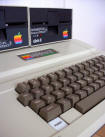 After Wozniak had completed design on the Apple-1, he already had in mind enhancements that would make his computer faster and more functional. He wanted to make it display in color. He worked to combine the terminal and memory functions of the Apple-1 by moving the display into main memory, allowing instant screen changes. None of these modifications were made specifically to make it a better product, or to make it more attractive for a customer to purchase.
After Wozniak had completed design on the Apple-1, he already had in mind enhancements that would make his computer faster and more functional. He wanted to make it display in color. He worked to combine the terminal and memory functions of the Apple-1 by moving the display into main memory, allowing instant screen changes. None of these modifications were made specifically to make it a better product, or to make it more attractive for a customer to purchase.
Built in 1977, the Apple II was based on Wozniak’s Apple I design, but with several additions. The first was the design of a plastic case–a rarity at the time–which was painted beige. The second was the ability to display color graphics–a holy grail in the industry. The Apple II also included a larger ROM, more expandable RAM (4K to start), and 8 expansion slots. It had integer BASIC hard-coded on the ROM for easier programming, and included two game paddles and a demo cassette for $1,298. In early 1978 Apple also released a disk drive for the machine, one of the most inexpensive available. The Apple II remained on the Apple product list until 1980. It was also repackaged in a black case and sold to educational markets by Bell & Howell.
